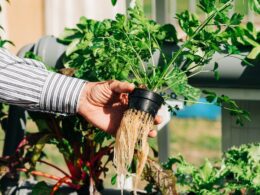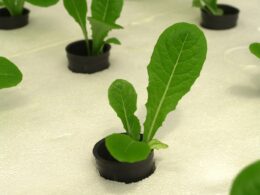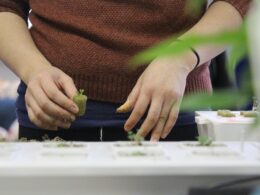Are you interested in growing your own tomatoes but don’t have a lot of space or experience with traditional gardening? Hydroponic growing may be the solution for you! Hydroponic tomato growing has many advantages, including faster growth, higher yields, and the ability to grow in small spaces.
In this article, we will explore the easiest tomato varieties to grow hydroponically and provide tips for a successful harvest. When it comes to hydroponic tomato growing, it’s important to choose the right varieties that are well-suited for this method. Some tomatoes may require more care and attention than others, making them more challenging for beginners. However, there are several varieties that are known for their ease of growth and high success rates in hydroponic systems.
With the right knowledge and preparation, you can enjoy a bountiful harvest of fresh, tasty tomatoes right from your own home. So let’s dive in and explore the easiest tomatoes to grow hydroponically!
Advantages of Hydroponic Tomato Growing
You’ll be amazed by the numerous benefits of growing your own fresh and healthy tomatoes using hydroponic methods. Hydroponic tomato growing has many advantages over traditional soil-based methods.
First of all, growing hydroponically is a sustainable way to produce food. Hydroponic systems require less water and fertilizers than traditional soil-based methods, making them more eco-friendly.
Another advantage of hydroponic tomato growing is that it allows you to control the growing conditions. With hydroponics, you can easily adjust the nutrient levels and pH of the water to ensure your tomatoes are getting the optimal amount of nutrients. You can also control the temperature and humidity of the environment, which can help prevent disease and pests from attacking your plants.
Finally, hydroponic tomato growing is a great way to save space. Hydroponic systems are very versatile and can be set up in small spaces like a balcony or a windowsill. You can grow more plants in a smaller area than you would be able to with traditional soil-based methods.
In summary, hydroponic tomato growing has many advantages, including sustainability, control over growing conditions, and space-saving capabilities. It’s a great way to grow your own fresh and healthy tomatoes at home.
Characteristics of Tomatoes Suited for Hydroponic Growing
If you’re interested in hydroponic tomato growing, it’s important to know the characteristics of tomatoes that are best suited for this type of cultivation. Look for varieties with a compact growth habit that won’t take up too much space in your hydroponic system.
You’ll also want to choose tomatoes with high yield potential and good disease resistance to ensure a successful harvest.
Compact Growth Habit
With a compact growth habit, you’ll be amazed at how much space you can save while still achieving a bountiful harvest.
In hydroponic gardening, the size of your plants can greatly impact the success of your harvest. That’s why it’s recommended to choose dwarf tomato varieties when growing tomatoes indoors. These plants have shorter stems and a bushy growth habit, making them an ideal choice for those with limited space.
Compact tomato plants are also easier to manage and require less pruning than their larger counterparts. Plus, they tend to produce more fruit per plant, which means a higher yield for you.
So, if you’re looking to grow tomatoes hydroponically, consider choosing varieties that have a compact growth habit. Not only will you save space, but you’ll also enjoy a bountiful harvest of delicious, homegrown tomatoes.
High Yield Potential
The potential for a high yield in hydroponic gardening greatly increases with careful consideration of plant varieties that exhibit a prolific growth habit. When choosing tomatoes to grow hydroponically, you should look for those that are known for their high yield potential. Varieties such as cherry tomatoes, beefsteak tomatoes, and Roma tomatoes are good options to consider.
To optimize yield, it’s important to manage the nutrient levels in your hydroponic system. Tomatoes require a balanced mix of macronutrients, including nitrogen, phosphorus, and potassium, as well as micronutrients such as calcium and magnesium. Regular monitoring and adjustment of nutrient levels will help ensure that your plants are receiving the nutrients they need to produce a bountiful harvest.
With the right tomato varieties and nutrient management, you can enjoy a high yield of fresh, delicious tomatoes from your hydroponic garden.
Disease Resistance
Growing vegetables hydroponically offers the advantage of disease resistance, ensuring that your harvest remains healthy and bountiful.
When it comes to tomatoes, there are certain varieties that are known for their disease resistance. For example, the Mountain Magic tomato is known for its resistance to both early and late blight, as well as other common tomato diseases. This variety is also known for its high yield potential and is a great choice for hydroponic growers.
Another tomato variety that is popular among hydroponic growers for its disease resistance is the San Marzano. This variety is resistant to verticillium and fusarium wilt, two common tomato diseases. Additionally, the San Marzano has low nutrient requirements, making it an easy tomato to grow in a hydroponic system.
With its disease resistance and low nutrient requirements, the San Marzano is a great choice for hydroponic growers who want a healthy and easy-to-grow tomato.
Can the Easiest Tomatoes to Grow Hydroponically Also Grow Quickly?
When it comes to tomato growth timeframe in hydroponics, it is important to consider whether the easiest tomatoes to grow hydroponically can also grow quickly. While certain tomato varieties may be easier to cultivate without soil, their growth rate can vary. Factors such as genetic characteristics, nutrient availability, and environmental conditions can influence how quickly tomatoes thrive in a hydroponic system.
Best Hydroponic Tomato Varieties for Beginners
For novice hydroponic gardeners, the following tomato varieties are an excellent starting point.
First, the cherry tomato is a great choice due to its small size and low maintenance. These tomatoes are also known to be disease-resistant, making them perfect for beginners. You can choose from a variety of cherry tomato types, such as Sweet 100, Sun Gold, and Grape Tomato.
Another easy-to-grow tomato variety is the Roma tomato. These tomatoes have a thick flesh, which makes them perfect for sauces and canning. When selecting seeds for Roma tomatoes, it’s important to choose a variety that is disease-resistant.
Growing Roma tomatoes is easy, even for beginners. They require a lot of sunlight, so if you’re growing indoors, make sure to provide them with enough light.
Finally, Beefsteak tomatoes are also a great choice for novice hydroponic gardeners. These large tomatoes have a meaty texture and are perfect for slicing. When growing Beefsteak tomatoes, it’s important to provide them with enough space to grow as they can grow up to 1-2 pounds.
As with the other tomato varieties, it’s important to select seeds that are disease-resistant and to provide them with enough sunlight or artificial light if growing indoors.
By choosing any of these easy-to-grow tomato varieties, you can have a successful hydroponic garden. With proper seed selection and growing techniques, you can enjoy fresh, juicy tomatoes all year round, whether you choose indoor or outdoor growing.
Remember to provide your plants with enough light, nutrients, and care, and you’ll be rewarded with a bountiful harvest.
Tips for Growing Tomatoes Hydroponically
When growing tomatoes hydroponically, you need to pay attention to important factors such as choosing the right nutrient solution, providing proper lighting and temperature, and using the right pollination techniques.
First, make sure you choose a nutrient solution that’s specifically designed for hydroponic tomatoes.
Next, ensure that your plants receive sufficient light and are kept at the appropriate temperature.
Finally, consider using hand pollination or introducing bees to ensure successful pollination and a good yield.
With these tips in mind, you can enjoy a bountiful harvest of delicious hydroponic tomatoes.
Choosing the Right Nutrient Solution
Picking the correct nutrient solution is crucial for your hydroponic tomato plants to thrive. Hydroponic nutrient mixtures are specifically designed to provide all the necessary nutrients to your plants, without the need for soil. These mixtures can be bought pre-made or can be created through a mix of individual nutrients.
When selecting a hydroponic nutrient mixture, it’s important to consider the pH balancing techniques needed. The pH level of your nutrient solution should be between 5.5-6.5 for ideal tomato growth. If the pH is too high or too low, plants may not be able to absorb the nutrients they need.
To maintain the correct pH balance, you can use pH testing strips or a pH meter to monitor the levels and adjust accordingly. By selecting the right nutrient solution and maintaining proper pH levels, your hydroponic tomato plants will have the best chance of thriving.
Proper Lighting and Temperature
Now that you’ve chosen the right nutrient solution for your hydroponic tomatoes, it’s time to focus on proper lighting and temperature to ensure optimal growth and yield.
Light and temperature are crucial factors in hydroponic tomato growing as they can affect the plant’s overall health and productivity.
To start, make sure your hydroponic system provides enough light for your tomatoes. Ideally, you should aim for 14-16 hours of light per day. This will help your plants produce healthy leaves and sturdy stems, which are essential for fruit development.
Additionally, maintain an optimal temperature range of 70-80°F during the day and 60-70°F at night. This will encourage proper root growth and prevent nutrient deficiencies, which can lead to stunted growth and low yields.
Don’t forget to regularly check and adjust your lighting and temperature settings as needed to ensure your tomatoes get the best conditions for growth and development.
Aside from lighting and temperature, it’s also crucial to maintain optimal water levels and nutrient ratios for your hydroponic tomatoes. This means regularly checking and adjusting your nutrient solution based on your plants’ needs and monitoring the pH balance.
The pH level should be kept between 5.5 and 6.5 to ensure your plants can absorb the nutrients they need. By paying attention to these factors, you can help your hydroponic tomatoes thrive and produce bountiful yields.
Pollination Techniques
Maintaining proper pollination techniques is essential for maximizing the productivity of your hydroponic tomato plants. Unlike outdoor tomato plants that rely on natural pollination from bees and other insects, indoor hydroponic tomato plants need a little help to ensure that their flowers are properly pollinated.
There are different pollination techniques that you can use, such as hand pollination, shaking the plants, or using an electric toothbrush to vibrate the flowers and distribute the pollen.
The importance of pollination in hydroponic tomato growing can’t be overstated. Without proper pollination, your tomato plants will produce fewer fruits, and the fruits that do develop may be small, misshapen, or have poor flavor.
By using the right pollination techniques, you can help your hydroponic tomato plants reach their full potential and produce a bountiful harvest of delicious, juicy tomatoes.
Harvesting and Enjoying Your Hydroponic Tomatoes
It’s time to savor the fruits of your labor and relish the delicious taste of fresh, homegrown tomatoes right from your hydroponic system. Once your tomatoes have ripened and turned a deep red color, it’s time to harvest them. Gently twist the tomato off the stem, being careful not to damage the plant or nearby tomatoes.
Now that you have a bountiful harvest of hydroponic tomatoes, it’s time to enjoy them in a variety of ways. From classic caprese salads to homemade tomato sauce, there are plenty of tomato recipes to try.
If you find yourself with more tomatoes than you can eat, consider storing them for later use. You can freeze them, can them, or even dry them to enjoy throughout the year.
As you indulge in the sweet, juicy taste of your hydroponic tomatoes, remember the benefits of growing your own food. Not only do you have the satisfaction of knowing exactly where your food came from, but you also have the peace of mind that comes with knowing it was grown without harmful chemicals.
Keep experimenting with your hydroponic system and enjoying the delicious fruits of your labor.
Frequently Asked Questions
What is the cost of setting up a hydroponic tomato growing system?
Looking to set up a hydroponic tomato growing system? The cost of such a system can vary depending on your specific needs and preferences, but in general, you can expect to invest anywhere from a few hundred to a few thousand dollars.
While this may seem like a significant upfront cost, keep in mind that hydroponic systems offer efficient space utilization and can result in higher yields compared to traditional soil-based methods. Plus, with the ability to control factors such as light, temperature, and nutrient levels, you can optimize your plants’ growth and health.
So if you’re looking to grow fresh, delicious tomatoes in a space-efficient and cost-effective way, a hydroponic system may be just what you need.
What are the common pests and diseases that affect hydroponic tomatoes?
If you’re growing hydroponic tomatoes, it’s important to be aware of the common pests and diseases that can affect your plants. Some of the most common pests include aphids, spider mites, and whiteflies.
To effectively control these pests, you can use insecticidal soaps or oils, as well as natural predators like ladybugs or lacewings. It’s also important to maintain a clean growing environment and to promptly remove any infected or damaged plant material.
By taking these measures, you can help ensure that your hydroponic tomato plants stay healthy and productive.
How often do hydroponic tomatoes need to be watered and fertilized?
To keep your hydroponic tomatoes thriving, it’s important to establish a consistent watering and fertilizing schedule.
In general, hydroponic tomatoes need to be watered every day or every other day, depending on the humidity levels in your growing space. It’s important to monitor the moisture levels of your growing medium to ensure that your plants aren’t overwatered or underwatered.
Organic fertilizers are highly recommended for hydroponic tomato plants. These fertilizers provide a slow release of nutrients, leading to healthier and more flavorful tomatoes.
Regular pruning of your tomato plants can encourage healthy growth and higher yields.
By maintaining a consistent watering and fertilizing schedule and using organic fertilizers, you can ensure that your hydroponic tomatoes will thrive and produce delicious fruit.
Can hydroponic tomatoes be grown outdoors or do they need to be grown indoors?
When it comes to growing hydroponic tomatoes, you may be wondering whether they should be grown indoors or outdoors. The truth is, both options are viable, but each has its own advantages.
Indoor hydroponic systems provide a controlled environment that allows for year-round growing and protection from pests and weather conditions. On the other hand, growing hydroponic tomatoes outdoors can be more cost-effective, as you don’t need to invest in lighting and climate control systems. Additionally, outdoor plants benefit from natural sunlight and fresh air, which can lead to stronger and healthier plants.
Ultimately, the decision comes down to your personal preferences and the resources you have available.
Are there any specific lighting requirements for hydroponic tomato plants?
When it comes to hydroponic tomato plants, it’s important to consider the lighting requirements. The light spectrum can have a significant impact on the growth rate of your plants, so it’s worth exploring tomato growth under different lighting conditions.
Additionally, the taste of your hydroponic tomatoes can vary depending on the type of lighting they receive. Comparing flavor profiles of different varieties grown under varying light conditions can help you find the perfect balance for your taste buds.
To ensure the best results, make sure you choose a lighting system that provides the right spectrum for your plants and monitor the intensity and duration of light exposure. With the right lighting, you can enjoy delicious hydroponic tomatoes that are both easy to grow and full of flavor.
Conclusion
Congratulations! You now have all the information you need to start growing delicious hydroponic tomatoes in your own home. Hydroponic tomato growing has many advantages over traditional soil growing, such as faster growth and higher yields.
To ensure success, choose tomato varieties that thrive in hydroponic systems, such as the Cherry and Beefsteak varieties. With a little bit of knowledge and effort, you can have a bountiful harvest of juicy, flavorful tomatoes that are perfect for salads, sauces, and sandwiches.
Follow the tips provided and enjoy the satisfaction of growing your own fresh produce year-round. Happy growing!









